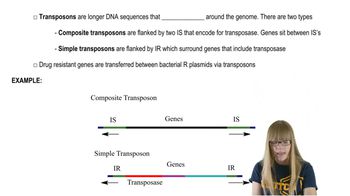Table of contents
- 1. Introduction to Genetics51m
- 2. Mendel's Laws of Inheritance3h 37m
- 3. Extensions to Mendelian Inheritance2h 41m
- 4. Genetic Mapping and Linkage2h 28m
- 5. Genetics of Bacteria and Viruses1h 21m
- 6. Chromosomal Variation1h 48m
- 7. DNA and Chromosome Structure56m
- 8. DNA Replication1h 10m
- 9. Mitosis and Meiosis1h 34m
- 10. Transcription1h 0m
- 11. Translation58m
- 12. Gene Regulation in Prokaryotes1h 19m
- 13. Gene Regulation in Eukaryotes44m
- 14. Genetic Control of Development44m
- 15. Genomes and Genomics1h 50m
- 16. Transposable Elements47m
- 17. Mutation, Repair, and Recombination1h 6m
- 18. Molecular Genetic Tools19m
- 19. Cancer Genetics29m
- 20. Quantitative Genetics1h 26m
- 21. Population Genetics50m
- 22. Evolutionary Genetics29m
12. Gene Regulation in Prokaryotes
Riboswitches
Problem 29b
Textbook Question
The bacterial insertion sequence IS10 uses antisense RNA to regulate translation of the mRNA that produces the enzyme transposase, which is required for insertion sequence transposition. Transcription of the antisense RNA gene is controlled by POUT, which is more than 10 times more efficient at transcription than the PIN promoter, which controls transposase gene transcription. If a mutation reduced the transcriptional efficiency of so as to be equal to that of , what is the likely effect on the transposition of IS10?
 Verified step by step guidance
Verified step by step guidance1
Identify the role of antisense RNA in regulating transposase production. Antisense RNA binds to the mRNA of the transposase gene, preventing its translation.
Understand the function of the POUT promoter. It controls the transcription of the antisense RNA, which is crucial for regulating transposase production.
Recognize the role of the PIN promoter. It controls the transcription of the transposase gene, which is necessary for IS10 transposition.
Consider the effect of a mutation that reduces the transcriptional efficiency of POUT to be equal to that of PIN. This would decrease the production of antisense RNA.
Predict the outcome of reduced antisense RNA levels. With less antisense RNA, more transposase mRNA would be translated, potentially increasing IS10 transposition.
Recommended similar problem, with video answer:
 Verified Solution
Verified SolutionThis video solution was recommended by our tutors as helpful for the problem above
Video duration:
4mPlay a video:
Was this helpful?
Key Concepts
Here are the essential concepts you must grasp in order to answer the question correctly.
Antisense RNA
Antisense RNA is a strand of RNA that is complementary to a specific mRNA strand. It can bind to the mRNA and inhibit its translation, effectively regulating gene expression. In the context of IS10, the antisense RNA regulates the translation of transposase, which is crucial for the transposition process. Understanding this mechanism is essential for analyzing how changes in transcription efficiency can impact transposase production.
Recommended video:
Transcriptional Efficiency
Transcriptional efficiency refers to the rate at which a gene is transcribed into mRNA. It is influenced by various factors, including promoter strength and regulatory elements. In this scenario, the POUT promoter is significantly more efficient than the PIN promoter, affecting the levels of antisense RNA and transposase. A mutation that equalizes these efficiencies would likely alter the balance of these regulatory RNAs, impacting transposition rates.
Recommended video:
Guided course

Eukaryotic Transcription
Transposition
Transposition is the process by which a transposable element, such as IS10, moves from one location in the genome to another. This process is mediated by the enzyme transposase, which is produced in response to the transposase gene's transcription. The efficiency of transposition is directly linked to the levels of transposase available, making it crucial to understand how regulatory mechanisms like antisense RNA influence this process.
Recommended video:
Guided course

Prokaryotic Transposable Elements
Related Videos
Related Practice





